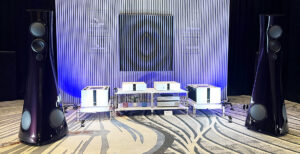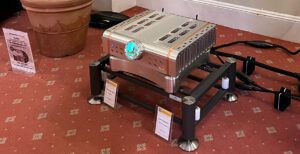
A significant page on the JH Audio website declares that, “JH Audio combines over 25 years’ experience in live audio mixing with more than 15 years of designing and building in-ear monitors…” The firm, founded by ex-Ultimate Ears principal Jerry Harvey, got its start by building custom-fit in-ear headsets for aviation applications, but at the earliest opportunity Harvey soon returned to his first love, which is building world-class in-ear music monitors, for use both my working musicians and by audiophiles. By tradition, Harvey’s ever growing family of IEMs is collectively known as JH Audio Pro Series monitors.
My first exposure to JH Audio came back in 2010 when I reviewed what was then the firm’s flagship offering: namely, the first-generation JH16 Pro custom-fit in-ear monitor (here’s a link to my 2010 Playback review of the JH16 Pro: https://hifiplus.com/articles/jh-audio-jh16-pro-custom-fit-in-ear-monitor-playback-35/). At the time, the JH16 Pro was not only a sonic revelation to me, but also seemed an absolute marvel of miniaturization in that it was a three-way, 8-balanced armature-driver, triple bore CIEM—one of the most sophisticated products of its type then on the market.
Over the intervening years, however, Jerry Harvey and team have not rested on their laurels. On the contrary, they’ve continued to push the limits of what’s possible in CIEM design. Now it’s been my experience that many makers of CIEMs seem to approach their work in much the same way that skilled Pro-Audio sound technicians might go about setting up onstage monitor mixes for musicians. What I mean by this is that the emphasis, often, is not on sonic neutrality or faithfulness to the source, per se; rather, the emphasis is on producing a sound that reveals whatever the musician in question wants to have revealed about the music, whether for good or ill.
Speaking as an audiophile, though, one of the things that have always impressed me about Jerry Harvey is that he cares (and cares very deeply) about accuracy, resolution, detail, and sonic neutrality in very much the same way that high-end audio enthusiasts do. Thus, Harvey’s designs have typically used balanced armature-type earpiece drivers for their speed and transient agility, and have used combination of multiple balanced armature drivers as a means of achieving greater dynamic range. Moreover, Harvey has done a better job than most of giving his CIEM’s a voicing curve that offers an admirable (and, for some, elusive) combination tonal neutrality coupled with a comfortable—never piercing—easy-to-listen-to quality.
Still, Harvey remained troubled by one thorny design question: Is there a way to combine the outputs of multiple drivers so that they not only yield smooth, linear frequency response, but also so that they also yield smooth, linear phase response? (The first-generation JHAudio Pros got the former part right, but not the latter). However, after considerable thought and experimentation, Harvey came up with a technical solution dubbed “Freqphase”, which is a very cleverly conceived, and now patented, waveguide system that allows CIEM’s to achieve flat frequency and phase response simultaneously.
A little over a year ago, though, Harvey took another big step forward with the release of the first model in what is eventually destined to become of range of ultra-high-end CIEM’s collectively called the Siren series (that’s Siren as in the beautiful winged, female Sirens of Greek mythology whose lovely music and voices were said to lure unwary sailors onto the rocks). That first Siren model was called the Roxanne ($1649, and up), and its technical highlights are most impressive.
For starters, the Roxanne is a three-way, 12 balanced armature-driver, triple bore CIEM featuring the firm’s proprietary Freqphase time|phase WaveGuide and—check this out—a passive, in-line variable bass output level control that allows the left or right channel earpieces to be adjusted independently for anything from flat bass response on up to +15dB of low-frequency boost in the region between 10 Hz to 100 Hz. Claimed frequency response is 10 Hz to 23 kHz, input sensitivity is a very high 119dB @ 1mW, and nominal impedance is 15 Ohms. For those who might be wondering about this, Roxanne driver array consists of a set of quad low-frequency drivers, quad midrange drivers, and quad high-frequency drivers in each earpiece (man, that’s a boatload of drivers to fit within a very, very tiny space!).
Naturally, we requested a review pair of Roxanne’s back in 2013, but we did so knowing that our wait was apt to be a very long one. I say this because, quite frankly, market response to the Roxanne was so strong and so favourable that the model was on backorder more or less from the moment of its release. It did not help that the first runs of Roxanne’s sport earpiece housing made of carbon fibre—a material that is quite a bit more difficult to work with than the traditional acrylic materials typically used for CIEM earpiece housing (this is because carbon fibre must be cured in an autoclave rather than the much simpler and quicker-acting UV curing chambers used for acrylic earpieces. JH Audio, in an attempt to keep up with demand, worked longer hours, added a second production shift, and even built CIEMs on weekends, but through most of 2014 demand still outstripped production.
Lately, however, JH Audio has continued to add production capacity and has given buyers the option of ordering their Roxanne’s with traditional acrylic earpieces, which not only cost bit less, but also are simpler, to make. Thus, after more than a year’s wait, our review samples arrived just last week. And guess what? They were worth the wait.
You might be asking yourself how a premium-priced, highly-personalised audio product such as the Roxanne could become such an obvious, runaway marketplace success, but I think I now know the answer. They sound flippin’ fantastic. Full stop.
Very early on, one sonic characteristic that immediate made its presence felt was a quality of uncanny integration or synchronisation between the fundamentals and upper harmonics of notes. When this quality is missing, and it is missing in a great many contemporary CIEMs and universal-fit earphones, you can still enjoy the sensation of hearing good-to-great hi-fi. But when the qualities of integration and synchronisation are right (really right, as they are in the Roxanne) you can break on through from the realm of good hi-fi to the sonic space where you get glimpses (and sometime more than just glimpses) of sonic realism, which can be quite breathtaking to behold.
Another aspect of the Roxanne that is distinctive is its variable bass output feature. Regular Hi-Fi+ readers may recall in our initial blog on the Noble Audio Kaiser 10 CIEM that that remarkable product incorporates a deliberate touch of bass lift that—in many listening contexts—serves to enhance perceived musicality. Apparently, Jerry Harvey and his team were thinking along similar lines, though they had the wisdom to let the listener decide how much, if any, bass lift is desirable in any given listening contexts. Over time, I found I mostly listened to the Roxanne’s with their deep, powerful, but tightly controlled and very articulate bass set for flat response, but I admit I did have fun experimenting, at times, with the Roxanne’s variable bass out put feature.
Although we have not yet firmed up plans, there is a good chance that Hi-Fi+ will do a full-length review of the Roxanne in the coming months. If that proves to be the case, you can expect even more in-depth commentary on the Roxanne’s sound. In the meantime, if you have a chance to hear the Roxanne’s, we’re confident in saying you most certainly will not be disappointed. For now, the Roxanne lives at or at the very least near this author’s list of the greatest in-ear transducers he’s yet heard.
Until next time, happy listening.
Tags: FEATURED
By Chris Martens
More articles from this authorRead Next From Blog
See all
AXPONA 2024 Show Report Part One
- Apr 19, 2024

Audio Show Deluxe 2024: A photo show report
- Mar 28, 2024

Paul Messenger 1949-2024: A personal tribute
- Mar 26, 2024

Bristol Hi-Fi Show 2024: See You There!
- Feb 21, 2024














